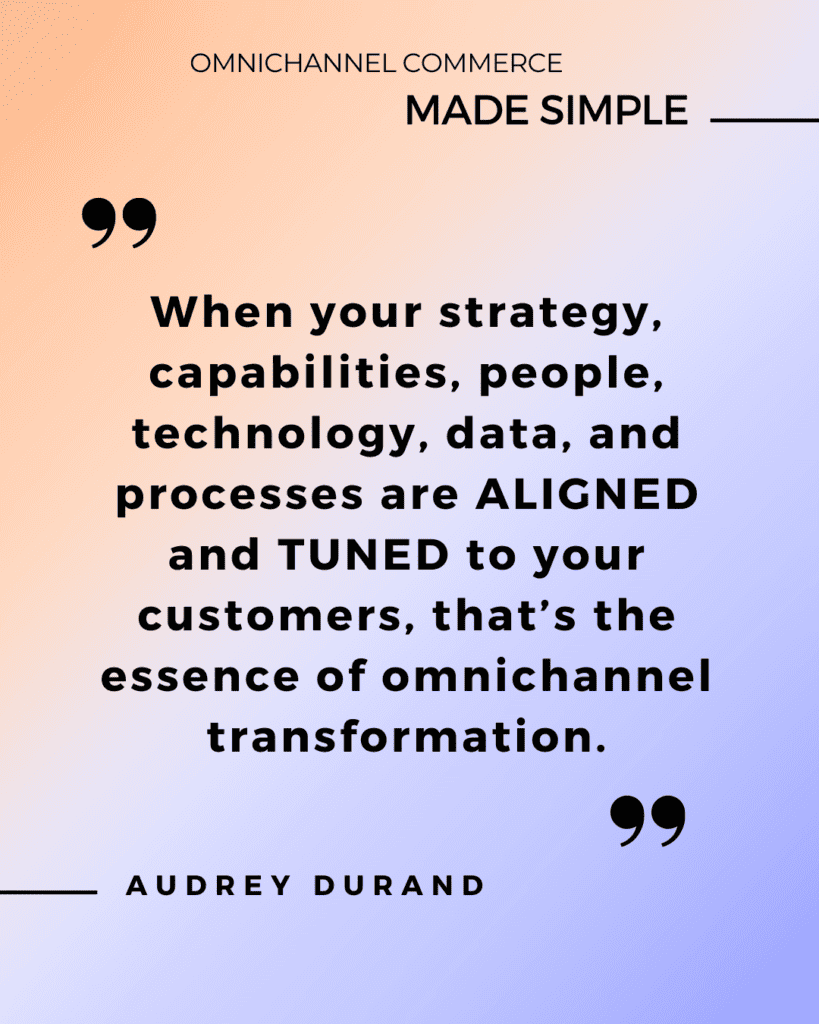In today’s hyper-connected digital landscape, businesses are constantly seeking innovative strategies to engage with consumers across multiple touchpoints seamlessly.
Omnichannel strategy acts as a comprehensive business model, aligning operations and technologies to prioritize customer satisfaction. It entails seamlessly blending digital platforms, brick-and-mortar stores, mobile apps, social media, and any other touchpoint where customers interact with the brand.
Whether you are a business leader trying to build the vision of your Commerce, C-level executives trying to make sense of data and plan marketing investments for your functional department (Brand, Sales, Operations, Performance Marketing, Data, etc.), or you are a functional strategist, consultant, or head of project delivery, orchestrating and executing campaigns across channels and touchpoints, it is essential to become more agile and fluent in navigating omnichannel strategies to build successful plans.
To be successful, you should embrace using a dynamic approach that breaks the silos of traditional marketing to deliver a unified, integrated, and immersive brand experience across various channels, be it online or offline.
Let’s dive into how Commerce brands evolved to omnichannel, and how to build and execute successful customer-centric strategies.
Understanding omnichannel experience
From multichannel to omnichannel
Moving from a multichannel to an omnichannel approach involves transitioning from a strategy where various channels operate independently to one where they seamlessly integrate to provide a unified customer experience.
In a multichannel setup, each channel (such as physical stores, websites, social media, and mobile apps) functions independently, often resulting in disjointed customer interactions.
On the other hand, an omnichannel approach aims to create a cohesive experience across all channels, allowing customers to switch between them seamlessly while maintaining continuity.
Shifting to an omnichannel approach requires deep integration of systems, data, and processes to ensure consistent messaging, branding, and service delivery regardless of the channel used.
Examples of omnichannel experiences
Here are a few examples of successful omnichannel strategies orchestrated by enterprise brands to enhance customer experiences;
- Sephora devised an omnichannel strategy aimed at seamlessly connecting online and offline experiences. Their loyalty program, which included additional perks, tutorials, and personalized freebies, allowed customers to redeem items picked up in-store from their online transactions.
- Disney revolutionized customer experience with My Disney Experience, enabling users to plan their entire trip through the Disney website and mobile app. Visitors could use the app’s locator in theme parks to find attractions and dining options, check wait times, purchase express passes online, and even access their hotel rooms using MagicBands.
- Starbucks tackled the challenge of converting first-time visits into loyal customers with their Rewards App. By focusing on building an omnichannel presence through the app, store locations, and personalized recommendations, Starbucks aimed to enhance customer loyalty. Once in-store, they provided complimentary Wi-Fi, along with access to discount codes, free beverages, and loyalty points, further incentivizing repeat visits.
Integrating online and offline channels
Integrating online and offline channels refers to creating a seamless and cohesive experience for customers across both digital and physical touchpoints. Here are some strategies and examples of how businesses achieve this integration:
- Consistent brand messaging
- Seamless cross-channel shopping experience
- Unified customer profiles
- Synchronization of online data and in-store inventories
- Buy online, pick up in-store (BOPIS)
- Using mobile apps for personalized in-store experiences
- Personalized promotions
- QR code integration
- Loyalty program integration
- Real-time inventory visibility
- And the list can go on
A successful omnichannel approach covers the entire customer journey with your brand from discovery to purchase and loyalty and integrates all channels to deliver a seamless, unified, and consistent experience across physical stores, apps, and websites.
But for that, you need to understand your customers and audiences first.
Take the time to learn first about your customers, trends in your market, and how their media consumption evolves through time, to best plan your investment in omnichannel marketing strategies.
Why does omnichannel experience matter for businesses?
Omnichannel experience matters for businesses because it enables them to meet the evolving expectations of modern consumers who demand seamless interactions across various touchpoints. This allows to enhance customer satisfaction, foster brand loyalty, and drive repeat purchases.
- According to Think With Google, omnichannel strategies can help generate about 80% of in-store visits by customers
- Companies with strong omnichannel marketing engagement retain more than 89% of their customers vs. companies with weak to no plans, retaining only about 33%.
- Brands with better omnichannel customer engagement have a 9.5% increase in annual revenue, compared to 3.4% for brands with poor omnichannel strategies
Sources: Google, Aberdeen Group, Digizuite
By providing a unified experience across online and offline channels, businesses can stay relevant and differentiate themselves in competitive markets, build stronger relationships with customers, and drive long-term growth and success.
Customers’ behaviors and needs are constantly evolving
Consumer preferences, purchasing habits, media consumption, and expectations are continuously shifting, driven by factors such as technological advancements, socio-economic changes, and cultural trends.
Omnichannel commerces must evolve too.
- Customers use an average of almost 6 touchpoints.
- Consumers’ attention span dropped from an average of 12 seconds to 8 seconds in the past 15 years.
- You have on average 2 seconds to capture Gen Z’s attention through ads.
- About 85% of digital customers begin purchasing on one device/channel and finish it on another.
- 80% of US adults want personalization from retailers with multiple, personalized touchpoints, including a mobile app, digital displays, and more.
- Nearly 40% of customers in a traditional brick-and-mortar store came via a mobile device.
Sources: TaylorSoft, Investp, CMO Council, Warc, McKinsey, bestmediainfo, Yahoo
What are the challenges for businesses?
- Only 11% of organizations claim to have a sophisticated omnichannel implementation.
- 64% of marketers said there is a lack of resources to build robust omnichannel plans.
Sources: Digizuite
There are many reasons commerce businesses and marketers struggle to navigate omnichannel strategies and transformations:
- Failure to comprehend the evolving behaviors of consumers.
- Absence of plans to adopt an omnichannel strategy.
- Intention to implement an omnichannel strategy, but not within the coming 12 months.
- Early-stage implementation without full integration across channels.
- Overly complex implementation due to a lack of in-house expertise.
- Difficulty in translating the omnichannel commerce concept into practical execution.
- Challenges in meeting customers at every touchpoint.
- Cultural resistance to change within the organization.
- Lack of buy-in from leadership
- Overemphasis on marketing channel mix and attribution, neglecting customer value and journey
How to overcome challenges and roadblocks and build – and execute – a robust omnichannel strategy?
Key elements of a seamless omnichannel experience
Successful omnichannel strategies are effective when the entire business or organization shares a customer-centric vision.

Core principles and themes of successful omnichannel strategies include:
- Unified customer data: Integrating customer data from various touchpoints to create a single view of the customer, allowing businesses to understand their preferences, behavior, and history regardless of the channel they engage with. Get a 360-degree customer view for personalization.
- Personalization and AI: Artificial intelligence (AI) and automation play key roles in driving successful omnichannel strategies. Utilize customer data to deliver personalized experiences, such as targeted recommendations, customized offers, and personalized communication, enhancing relevance and engagement. Leverage AI and machine learning algorithms to collect and analyze real-time data from various channels and propel personalization, automation, and processes at scale.
- Consistent brand messaging: Ensuring a consistent brand voice, messaging, and visual identity across all channels, maintaining coherence, and reinforcing brand values throughout the customer journey.
- Cross-channel connectivity: Facilitating smooth transitions between different channels, allowing customers to start an interaction on one channel and seamlessly continue it on another without interruption or repetition.
- Channel integration: Integrating online and offline channels to provide a cohesive experience, enabling customers to interact with the brand through multiple channels while maintaining consistency in products, pricing, and services. Channel-agnostic orchestration with APIs can support building an integrated experience.
- Flexible fulfillment options: Offering flexible fulfillment options such as buy online, pick up in-store (BOPIS), curbside pickup, or same-day delivery, providing convenience and choice to customers across channels. Real-time inventory visibility is also key to providing to supporting your entire omnichannel strategy, and creating frictionless experiences for your customers, improving customer loyalty and retention, and reducing the number of lost sales. Ask yourself: do you have enough of what your customers want? And across all channels, they interact?
- Seamless customer support: Providing consistent and seamless customer support across all channels, ensuring that customers receive timely assistance and resolution regardless of the channel they use to reach out.
- Omnichannel analytics: Leveraging analytics to track customer interactions and behaviors across channels, gaining insights into customer journeys and preferences to optimize future interactions and experiences.
- Continuous optimization: Regularly analyzing and optimizing the omnichannel experience based on customer feedback, emerging trends, and technological advancements to ensure ongoing improvement and relevance.
How to create and orchestrate an effective omnichannel strategy?
Identify your customer journeys
At this stage, you should invest time to get a deep understanding of your market, target audience, and existing customers.
- Conduct thorough research to understand your target audience’s preferences, behavior, and preferred communication channels. Understand who are your customers and how they buy from you. This will help tailor your omnichannel approach to meet their needs effectively.
- Study consumer behaviors’ changes, media consumption, and factors influencing purchase decisions, and review qualitative and quantitative research to (re)define your audience targeting and segmentation.
- Create detailed customer personas to guide your omnichannel approach and ensure it resonates with your audience.
- Focus on the journey to prioritize what needs to be done and map out these journeys to the likelihood of using multiple channels and their importance to your customer.
Understanding what drives and excites your customers is key.
Audit your current channels
When planning omnichannel commerce strategies, conducting an audit of current channels is crucial to understanding the existing landscape and identifying areas for improvement.
Begin by compiling a comprehensive list of all the channels through which your business interacts with customers. This includes physical stores, e-commerce websites, mobile apps, social media platforms, email marketing, phone support, and any other touchpoints.
Evaluate the performance of each channel individually, considering metrics such as sales volume, conversion rates, customer engagement, and customer satisfaction. Identify which channels are driving the most revenue and which ones may be underperforming.
Examine the technology infrastructure supporting each channel, including e-commerce platforms, point-of-sale systems, customer relationship management (CRM) software, and any other relevant tools. Assess whether these systems are capable of supporting your omnichannel strategy and identify any gaps or limitations that need to be addressed.
Research how competitors are leveraging various channels to engage with customers and drive sales. Identify any best practices or innovative strategies that can be adapted for your omnichannel commerce strategy.
Use the insights gained from the audit to develop a comprehensive omnichannel commerce strategy that aligns with the overall business goals and objectives. This strategy should outline how different channels will be leveraged to create a seamless and integrated customer experience.
Create a consistent brand messaging
To execute successful omnichannel strategies, you need to develop a unified brand voice and messaging that remains consistent across all channels. Ensure brand messaging aligns with the preferences and expectations of your target audience;
- Clearly define your brand identity including your values, mission, vision, and unique selling propositions (USPs).
- Understand your target audience on each channel and segment them based on demographics, psychographics, and behaviors to tailor your messaging effectively.
- Develop concise, memorable, and consistent messages that resonate with your target audience and stay true to your brand identity.
- Establish a consistent brand voice that reflects your brand’s personality.
- Develop your brand guidelines that outline how your brand should be represented visually and verbally across all channels. Include rules for logo usage, color schemes, typography, and language style.
- Develop an integrated content strategy that aligns with your brand messaging. This includes content for social media, website, email marketing, advertisements, and any other channels you use.
- Coordinate your cross-channel plan and keep the essence of your messaging consistent across different channels to ensure coherence.
- Utilize data and analytics to understand how your audience engages with your brand across different channels and can help you refine your messaging for better effectiveness.
- Establish a feedback loop to gather insights from customers and internal stakeholders about your brand messaging.
- Train your team members and stakeholders about the importance of consistent brand messaging and how to implement it effectively across various channels
Define your omnichannel KPIs and metrics
Measuring the efficiency and effectiveness of omnichannel strategies in a commerce business requires tracking key performance indicators (KPIs) that provide insights into various aspects of customer engagement, sales performance, and overall business success. Here are some of the most important omnichannel KPIs for commerce businesses:
- Customer Lifetime Value (LTV)
- Customer Acquisition Cost (CAC)
- Customer Retention Rate
- Return on Investment (ROI)
- Cross-Channel Engagement
- Customer Satisfaction (CSAT) Score
- Net Promoter Score (NPS)
- Conversion Rate by Channel
- Average Order Value (AOV)
- Channel Attribution
- Mobile Engagement
- Inventory Management Efficiency
Analyzing omnichannel KPIs requires collaboration among various stakeholders within the organization.
Data, Marketing, Sales, Customer Experience, Operations, and, Finance should regularly meet to review and make decisions based on how these metrics evolve.
Successful omnichannel strategies include regular reviews of these KPIs and business goals, data-driven insights, benchmarking, and robust cross-functional collaboration among the teams to interpret these omnichannel KPIs holistically and to develop actionable strategies for improvement.
Identify budget for resources and investments
Once you get a strategic plan in place, it is time to determine the investments needed for your omnichannel strategy.
This will help Identify any gaps or areas where revenue could be increased through omnichannel initiatives and optimize your financial resources to maximize the impact of your omnichannel initiatives on your bottom line.
Here’s how to plan:
- Assess current revenue streams from various channels, including online sales, B&M stores, and other distribution channels.
- Evaluate costs and expenses related to these channels, including marketing costs, operational expenses, technology investments, and personnel costs, while considering return on experience. Identify any inefficiencies or areas where costs could be reduced or reallocated.
- Identify potential revenue opportunities that could be unlocked through omnichannel initiatives, such as increased cross-selling and upselling opportunities, improved customer retention, and expanded market reach.
- Estimate the investment needed to implement your omnichannel strategy based on the gaps identified such as technology infrastructure, marketing and advertising campaigns, personnel training, and operational improvements.
- Forecast revenue impact on revenue growth based on the investments planned. Consider factors such as increased sales volume, improved customer lifetime value, and enhanced brand loyalty.
- Calculate ROI for your omnichannel strategy by comparing the projected revenue impact against the investment needed.
- Consider both short-term and long-term ROI projections to assess the overall financial viability of the strategy. Plan both 1-year and 3-5-year plans
- Prioritize Investments based on their potential to address P&L gaps and generate the highest ROI. Allocate resources strategically to initiatives that are expected to deliver the greatest financial impact in alignment with your business objectives.
- Continuously monitor and adjust the financial performance of your omnichannel strategy. Track key financial metrics such as revenue growth, profitability, and cost-effectiveness to ensure that your strategy remains on track.
Review, Iterate, Improve
Continuously review and refine your omnichannel strategy based on performance data, customer feedback, and market trends. Stay agile and be prepared to adapt your approach as needed to stay competitive and meet evolving customer needs.
Wrapping Up
We covered a lot!
By embracing omnichannel commerce strategies, businesses can meet customer expectations, foster loyalty, and stay competitive. It’s not just a trend; it’s a strategic necessity for sustained growth and success.
When navigating omnichannel strategies, stay agile and adaptive to changes in consumer behavior, market trends, and technological advancements.
Create a cohesive and consistent brand messaging strategy that resonates with your audience across all channels in your omnichannel approach.
Organizational alignment is also key to building successful omnichannel strategies and experiences; break down silos and encourage cross-functional teams to work together on initiatives such as marketing campaigns, customer service improvements, and product launches to deliver a cohesive brand experience.
Invest in technology platforms that facilitate seamless integration across channels, enabling real-time data synchronization, unified customer profiles, and consistent messaging.
Utilize customer relationship management CRM and CDP systems, inventory management software, and analytics tools to optimize operations and enhance the omnichannel experience.
Regularly revisit and refine your omnichannel strategy to ensure it remains relevant and effective in meeting your business objectives.
Success Starts with The Good Strategy!












